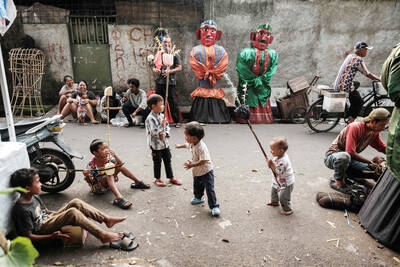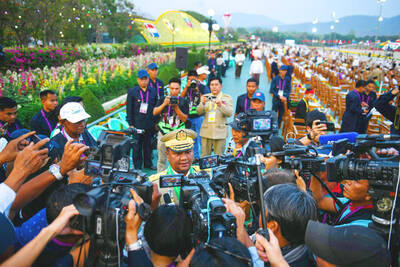There was to be a poignant wartime anniversary yesterday, but amid all the services commemorating the Battle of Britain and the blitz, this one has crept under the radar.
On Sept. 17, 1940, a passenger ship called the City of Benares was sunk by a German U-boat while crossing the Atlantic.
It was carrying 406 passengers and crew, of whom 100 were children being evacuated to Canada and the US, most of them as part of a government scheme organized by the Children’s Overseas Reception Board (CORB). Only 19 of the children survived.
When the U-boat’s crew got back to their base in France and discovered that the Benares’ cargo had been children, they wept.
Just nine of those child survivors are now alive, and sadly they have no plans to mark the 70th anniversary of the sinking.
“We’re all getting too old,” said Fred Steels, who was 11 when the Benares sank. “But at 9:45 [pm] on Friday, which is the time the ship was torpedoed, I’ll be thinking about it — the water rushing in and a bunk coming down on top of me. When I got out of the cabin there was a huge hole in the deck, and a dirty great seaman grabbed me and another boy and threw us into a lifeboat.”
They were among the fortunate few: The fact that the children were already in bed below deck and that most were traveling without their parents meant that a far higher proportion of children than adults were lost.
Derek Bech, then aged nine, was on board with his mother and two sisters — they were traveling as private passengers, not as part of the CORB scheme. One sister made it into a lifeboat; Bech, his other sister, and their mother survived by clinging to a tiny raft in rough seas.
“Some of the children were killed in the explosion,” he recalled, “some were trapped in their cabins and the rest died when the lifeboats were launched incorrectly and children were just tipped into the sea. All I can remember were the screams and cries for help. It was one of the worst disasters at sea concerning children, and it should always be remembered.”
Most of the survivors were picked up the following afternoon by British warship Hurricane, which had steamed 480km in answer to the Benares’ distress call, but one lifeboat — containing Steels, five other boys and 40 adults — had drifted off, and was picked up by the warship Anthony eight days later.
“We went through three storms, great Atlantic gales, before we were picked up,” Steels said. “We were frightened, but we tried not to show it. Every anniversary you stop and think about it — all the kids we knew. Two of the lads on the lifeboat with us lost their five-year-old brothers.”
The Hurricane was captained by Lieutenant-Commander Hugh Crofton Simms, and his son, Blake Simms, said the experience affected him deeply.
“He realized [once he’d decoded the distress call] that there were women and children on board, and went as fast as he could. He reached the estimated position at 2:30 in the afternoon, in a force eight gale and in mountainous seas, and saw the scattered remains of all these lifeboats, nearly every one of which had dead children in them. He dedicated the rest of his life to the destruction of the Hun,” Simms said.
One family had lost five children; others two or three. Unspeakable tragedies which, amid so much wartime suffering, went unspoken. In the wake of the sinking, the CORB evacuation plan was abandoned. Death at home among loved ones was deemed preferable to a lonely death at sea.

In the sweltering streets of Jakarta, buskers carry towering, hollow puppets and pass around a bucket for donations. Now, they fear becoming outlaws. City authorities said they would crack down on use of the sacred ondel-ondel puppets, which can stand as tall as a truck, and they are drafting legislation to remove what they view as a street nuisance. Performances featuring the puppets — originally used by Jakarta’s Betawi people to ward off evil spirits — would be allowed only at set events. The ban could leave many ondel-ondel buskers in Jakarta jobless. “I am confused and anxious. I fear getting raided or even

Eleven people, including a former minister, were arrested in Serbia on Friday over a train station disaster in which 16 people died. The concrete canopy of the newly renovated station in the northern city of Novi Sad collapsed on Nov. 1, 2024 in a disaster widely blamed on corruption and poor oversight. It sparked a wave of student-led protests and led to the resignation of then-Serbian prime minister Milos Vucevic and the fall of his government. The public prosecutor’s office in Novi Sad opened an investigation into the accident and deaths. In February, the public prosecutor’s office for organized crime opened another probe into

RISING RACISM: A Japanese group called on China to assure safety in the country, while the Chinese embassy in Tokyo urged action against a ‘surge in xenophobia’ A Japanese woman living in China was attacked and injured by a man in a subway station in Suzhou, China, Japanese media said, hours after two Chinese men were seriously injured in violence in Tokyo. The attacks on Thursday raised concern about xenophobic sentiment in China and Japan that have been blamed for assaults in both countries. It was the third attack involving Japanese living in China since last year. In the two previous cases in China, Chinese authorities have insisted they were isolated incidents. Japanese broadcaster NHK did not identify the woman injured in Suzhou by name, but, citing the Japanese

RESTRUCTURE: Myanmar’s military has ended emergency rule and announced plans for elections in December, but critics said the move aims to entrench junta control Myanmar’s military government announced on Thursday that it was ending the state of emergency declared after it seized power in 2021 and would restructure administrative bodies to prepare for the new election at the end of the year. However, the polls planned for an unspecified date in December face serious obstacles, including a civil war raging over most of the country and pledges by opponents of the military rule to derail the election because they believe it can be neither free nor fair. Under the restructuring, Myanmar’s junta chief Min Aung Hlaing is giving up two posts, but would stay at the